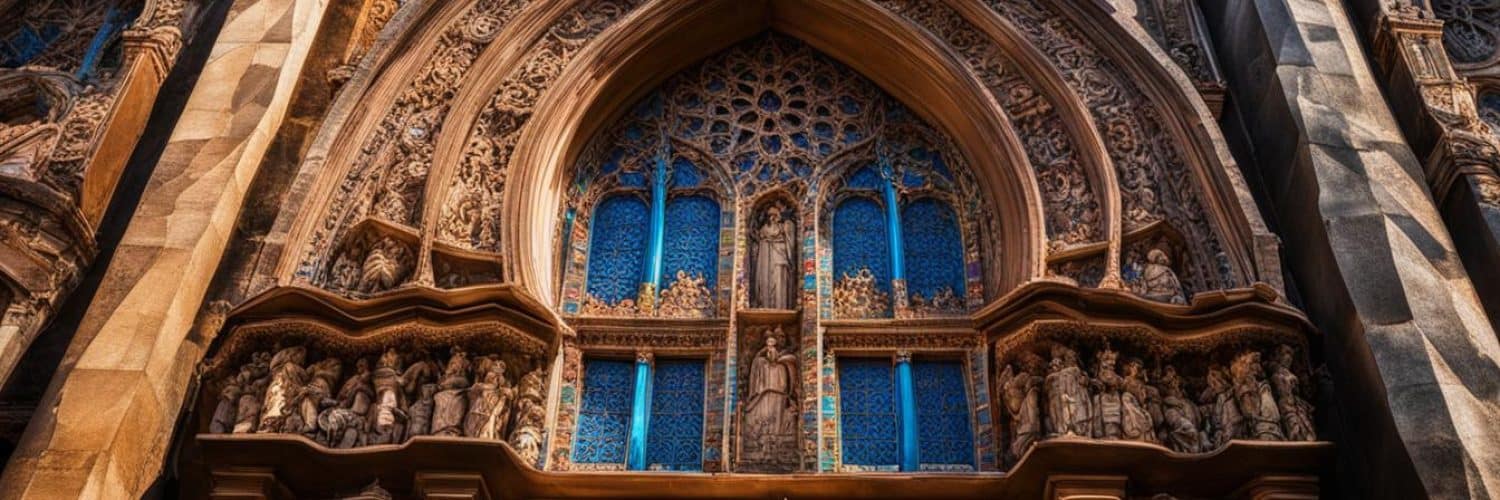Tucked away in the picturesque town of Talibon, Bohol, the Most Holy Trinity Cathedral, also known as Talibon Cathedral, stands as a remarkable testament to the rich history and enduring faith of the people. This comprehensive guide will take you on a captivating journey through the Talibon Cathedral, unveiling its architectural marvels, artistic treasures, and the captivating stories that have shaped its existence.
Key Takeaways:
- Talibon Cathedral is one of the top attractions in Bohol, Philippines, known for its historical and religious significance.
- The cathedral showcases impressive stone architecture with intricate details and a weathered facade.
- Its history dates back to the Spanish era, and it holds cultural and spiritual significance for the community.
- Visitors should be aware of the dress code and etiquette when visiting the cathedral.
- Taking a guided tour can enhance your experience and provide in-depth knowledge about the cathedral’s architecture and history.
The Splendor of Talibon Cathedral’s Architecture
The Talibon Cathedral in Bohol is not only a place of worship but also an architectural marvel that showcases the enduring presence of stone architecture in the region. Constructed with coral rock sourced from the nearby sea, this cathedral stands tall on an elevated plain, offering stunning views of the surrounding landscapes. Its aged facade, with weathered stone walls and intricate details, adds to the charm and evokes a sense of reverence.
As you approach the Talibon Cathedral, you can’t help but be captivated by its grandeur. The coral rock, painstakingly hauled by the local inhabitants and skillfully crafted, gives the cathedral a unique and enduring appearance. The architectural details, meticulously carved and designed, demonstrate the exceptional craftsmanship of the builders. Each curve and line tells a story of devotion and dedication, showcasing the rich cultural heritage of the region.
“The Talibon Cathedral stands as a testament to the ingenuity and artistic prowess of the people who built it. Its stone architecture and aged facade bring a sense of timelessness to the space, reminding us of the enduring presence of faith and tradition.”
Inside the cathedral, you will find a sanctuary that is both awe-inspiring and peaceful. The interplay of light and shadows casts a tranquil ambience, inviting visitors to reflect and find solace. The intricate details carved in stone and depicted in paintings breathe life into the space, telling stories of religious narratives and inspiring contemplation.
Whether you’re an architecture enthusiast or a curious traveler, the Talibon Cathedral’s architecture will undoubtedly leave an indelible impression. It is a testament to the resilience of stone craftsmanship and the enduring presence of faith.
The Enduring Charm of Stone Architecture
Stone architecture has stood the test of time and continues to captivate us with its timeless allure. Its longevity and durability make it a preferred choice for construction in many historical and cultural sites. The Talibon Cathedral’s stone architecture exemplifies this enduring charm, serving as a reminder of the architectural marvels that have graced the region for centuries.
| Benefits of Stone Architecture | Notable Examples |
|---|---|
| 1. Durability: Stone structures can withstand the test of time, enduring for centuries and preserving the architectural heritage. | 1. Taj Mahal, India – A mausoleum renowned for its intricate stone craftsmanship and breathtaking beauty. |
| 2. Aesthetics: The natural beauty and texture of stone create visually stunning structures that blend harmoniously with the surrounding environment. | 2. Angkor Wat, Cambodia – A magnificent temple complex featuring intricate stone carvings and architectural splendor. |
| 3. Sustainability: Stone is a sustainable material that requires minimal maintenance and has a low carbon footprint. | 3. Petra, Jordan – An ancient city carved into sandstone cliffs, showcasing the versatility and sustainability of stone architecture. |
Unraveling the Tapestry of History
The roots of the Talibon Cathedral run deep, intertwined with tales of struggle, resilience, and the indomitable spirit of faith. Long before Miguel Lopez de Legazpi arrived in 1565, Talibon was already being touched by the light of Christianity. Spanish survivors of the Cebu massacre found refuge in Talibon and became the first lay missionaries to Bohol. They evangelized the natives and dedicated the place to the Santisima Trinidad, the patron of their ship.
In 1596, Jesuit missionaries, Fr. Juan de Torres and Fr. Gabriel Sanchez, were sent to initiate spiritual activities in western Bohol. Talibon was chosen as the center of the diocese, which was named after the town upon its creation by virtue of a papal bull issued by Pope John Paul II on January 9, 1986. The construction of the permanent Talibon Cathedral commenced in 1852, and it was completed in 1899, serving as a testament to the unwavering faith and dedication of the community.
Cultural and Spiritual Significance
Beyond its architectural grandeur and historical significance, the Talibon Cathedral holds cultural and spiritual importance for the people of Bohol. The cathedral serves as a place of worship and devotion, offering solace and an opportunity for reflection to both locals and visitors alike.
As a place of worship, the Talibon Cathedral remains a sacred space where the community gathers to celebrate the sacraments and partake in religious ceremonies. It is a cherished sanctuary where individuals seek spiritual guidance, find peace, and strengthen their connection with the divine.
Moreover, the Talibon Cathedral serves as a repository of cultural and artistic heritage. Through its impressive architecture, intricately crafted sculptures, and captivating paintings, it showcases the artistic prowess and creative expression of the past.
The construction of the Talibon Cathedral using coral rock reflects the ingenuity of the local inhabitants, who transported these heavy blocks from the sea to create a lasting testament to their faith. The fusion of traditional stone craftsmanship and Spanish colonial influence has resulted in a unique architectural style that is emblematic of Bohol’s cultural heritage.
Within the walls of the cathedral, visitors can marvel at an array of sculptures and paintings that convey profound religious narratives. The central figure of the Holy Trinity, carved with remarkable precision, stands as a powerful symbol of divine unity and grace. The ceiling paintings, depicting heavenly beings, add a touch of ethereal beauty to the sacred space, inviting visitors to immerse themselves in a realm of spirituality and artistry.
Visiting the Talibon Cathedral allows one to not only appreciate its architectural splendor and historical significance but also to experience the cultural and spiritual treasures it holds. It is a place where faith and artistic expression converge, offering a glimpse into the vibrant cultural heritage of Bohol.
Key Features:
- Place of worship and devotion
- Cultural and artistic heritage
- Architectural marvels
- Intricately crafted sculptures
- Captivating paintings
Tips for Visitors
To ensure a fulfilling visit to the Talibon Cathedral, here are some practical tips to keep in mind:
- Opening Hours: The cathedral is generally open to visitors during daylight hours. However, it is advisable to check with local authorities or the parish office for specific visiting hours, as they may vary.
- Dress Code and Etiquette: As a place of worship, it is important to dress modestly and respectfully when entering the cathedral. Avoid wearing revealing or inappropriate clothing out of respect for the sacred atmosphere. Additionally, maintain a quiet demeanor and refrain from taking flash photography during religious ceremonies or events.
- Guided Tours: Consider arranging a guided tour of the Talibon Cathedral to gain deeper insights into its history, architecture, and artistic elements. Local tour operators or the parish office may offer guided tours or provide informative brochures to enhance your visit.
For additional information and to make the most of your visit, feel free to seek assistance from the friendly staff at the Talibon Cathedral. They can provide further guidance and help you explore the wonders of this cultural and spiritual landmark.
| Opening Hours | Dress Code and Etiquette | Guided Tours |
|---|---|---|
| Generally open during daylight hours | Dress modestly and respectfully | Arrange guided tours for deeper insights |
| Check with local authorities or the parish office for specific hours | Avoid revealing or inappropriate clothing | Local tour operators or the parish office may offer guided tours |
| – | Maintain a quiet demeanor during religious ceremonies or events | Informative brochures may be available |
Conclusion
The Talibon Cathedral in Bohol, Philippines is a magnificent architectural marvel and one of the region’s significant historical landmarks. It stands as a testament to the enduring faith and cultural heritage of the people of Talibon. This awe-inspiring cathedral showcases remarkable craftsmanship and is a must-visit destination for those seeking to explore the rich history and spiritual significance of the area.
Stepping inside the Talibon Cathedral, visitors are transported to a space where art, history, and faith intertwine. The intricate details of the cathedral’s stone architecture, the aged facade, and the artistic treasures within its walls all contribute to its cultural significance. This sacred place of worship holds a deep connection to the local community and offers visitors a chance to connect with the past and find solace in its serene ambiance.
A visit to the Talibon Cathedral offers a captivating journey into the heart of Bohol’s cultural heritage. Whether you are drawn by its architectural grandeur, historical significance, or the chance to immerse yourself in a place where faith has flourished for centuries, the Talibon Cathedral promises an enriching experience. It is a testament to the enduring spirit of the people of Talibon and a beacon of faith in the Philippines.
FAQ
What is the historical significance of Talibon Cathedral?
Talibon Cathedral holds great historical significance as it was the center of the diocese in Bohol and played a crucial role in the spread of Christianity in the region. It was also constructed as a testament to the unwavering faith and dedication of the local community.
What is the architectural style of Talibon Cathedral?
Talibon Cathedral showcases a unique architectural style that combines traditional stone craftsmanship with Spanish colonial influence. It is constructed with coral rock and features intricate details, giving it a timeless and awe-inspiring appearance.
What is the cultural and spiritual importance of Talibon Cathedral?
Talibon Cathedral not only serves as a place of worship but also as a repository of cultural and artistic heritage. It reflects the creative expression of the past through its sculptures, paintings, and architectural design, offering visitors a deeper understanding of the region’s cultural tapestry.
Are there any specific guidelines for visiting Talibon Cathedral?
When visiting Talibon Cathedral, it is important to dress modestly and respectfully. Visitors should also maintain a quiet demeanor and refrain from using flash photography during religious ceremonies or events. Checking with local authorities or the parish office for specific visiting hours is advisable.


















Add comment